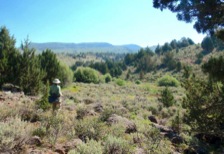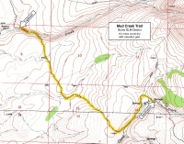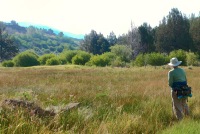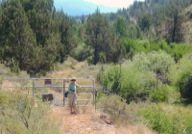Less Traveled Northwest
Day Hikes for the Adventurous
Mud Creek Trail
Hike Rating: Easy
Hike Length: 6.5 miles roundtrip
Elevation Gain: 620’
Trailhead Elevation: 5,280’
Best Season: June through September,
after spring runoff has subsided
Driving Access: High-clearance vehicle
Plus Points
• Easy walking on an old jeep road through sage-juniper uplands to a green oasis
• Mud Creek is a Wild-and-Scenic stream within the Steens Mtn. Wilderness Area
• The stream is spring-fed, so it usually has some water late into the year
• Cows are excluded, so streamside meadows, willows and wildflowers are pristine
• Songbirds, mule deer and red-tailed hawks are common in the stream canyon
• Solitude is likely, as only 3-4 groups per month now use this trail in summer
Minus Points
• Requires a ford of Indian Creek, which is only safe after Spring runoff has subsided
• Rattlesnakes are a possibility throughout the summer, so caution is advised
• Hike can be hot in midsummer, so plan to start in early AM and return by noon
Download (PDF, 574 KB): Photos of Mud Creek Trail
Download (PDF, 551 KB): Topo Map for Mud Creek Trail
Download (PDF, 505 KB): Road Map for Mud Creek Trail
Trail Notes
The hike starts at the “Wilderness Boundary” sign near a steel gate alongside Indian Creek. After 0.3 miles, one comes to a sign-in box and a wet-boot ford of Indian Creek. The jeep road then climbs steeply out of the canyon and, for the next mile, wanders south over rolling sage and juniper-covered uplands. There are nice views of the west side of the Steens range and the mouths of Big Indian and Little Blitzen Gorges.
At the 1.5 mile point, the road descends into a grassy swale and then climbs steadily for the next mile through open, nearly treeless grasslands, the result of a long-ago range fire in this area. At about 2.5 miles, the jeep road crests a ridge, bends sharply northeast, and then descends into the Mud Creek drainage.
For the next 0.8 miles, the jeep track runs through pristine wet meadows and along willow thickets, all spring-fed by the small flow of Mud Creek. Even in late summer, one finds wildflowers along this stretch, including lupine, buttercups and paintbrush. Look for mule deer bedded down in the streamside willows. One can wander at will upstream along the grassy meadows, though it’s best to follow the jeep road, as it skirts the wettest areas. At about 3 miles, the road makes a big switchback away from the stream (to go around a deeply-eroded tributary), but then quickly returns to a stream crossing. There is a good lunch spot and hike destination across the creek and 50 yards upstream under a shady grove of juniper trees.
Road to Trailhead
From the South Steens Campground, drive about 0.2 miles southwest on the Steens Mtn. Loop Road. Here you’ll find a dirt road joining from the southeast (directly across from the road to the Riddle Ranch). If this dirt road is dry and hard, turn southeast onto it and go as far as your vehicle is capable. In other words, low-clearance passenger cars may want to park right away, in one of the roadside pullouts, and walk to the trailhead. High-clearance vehicles can drive about 0.5 miles to a large pullout, just before the road drops steeply into the canyon. Don’t drive down this slope, as you can’t get back up it without 4-wheel drive. 4-wheel drive vehicles can drive the full 0.7 miles to the parking area along Indian Creek.
Camping Options
The only developed campground in the area is the South Steens Campground, managed by the BLM. It’s located 18 miles east of Hwy 205 on the Steens Mtn. Loop Road and is only a mile from the trailhead. This campground is split into two parts, with 21 standard sites for family campers and 15 sites for equestrians. The campsites are all dispersed through a juniper-covered grassland, some with shade and some more exposed. All have gravel parking pads, picnic tables and fire rings. Both campgrounds provide vault toilets, drinking water and trash cans. The fee was $6.00 per night in 2012.
Agency Contact: Burns BLM District, (541) 573-4411
DISCLAIMER: Every effort has been made to ensure the accuracy of this information, but the authors do not guarantee that it is either current or correct. The reader assumes full responsibility for any use of this information, and is encouraged to contact local federal land agencies to inquire about current conditions before traveling.
Page last updated: 1/16/13




